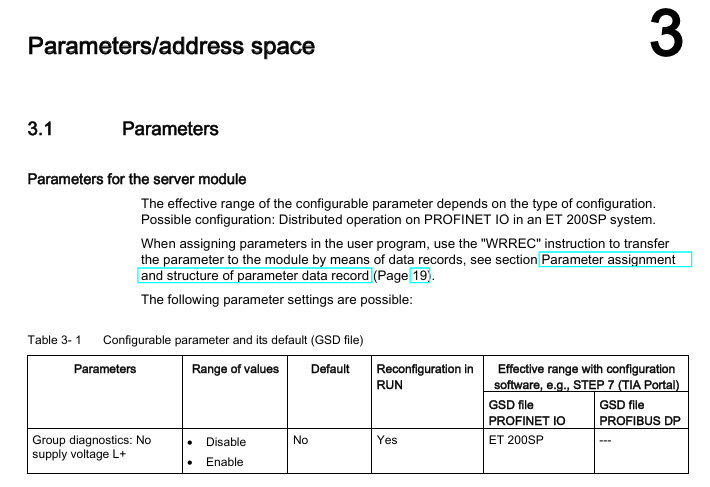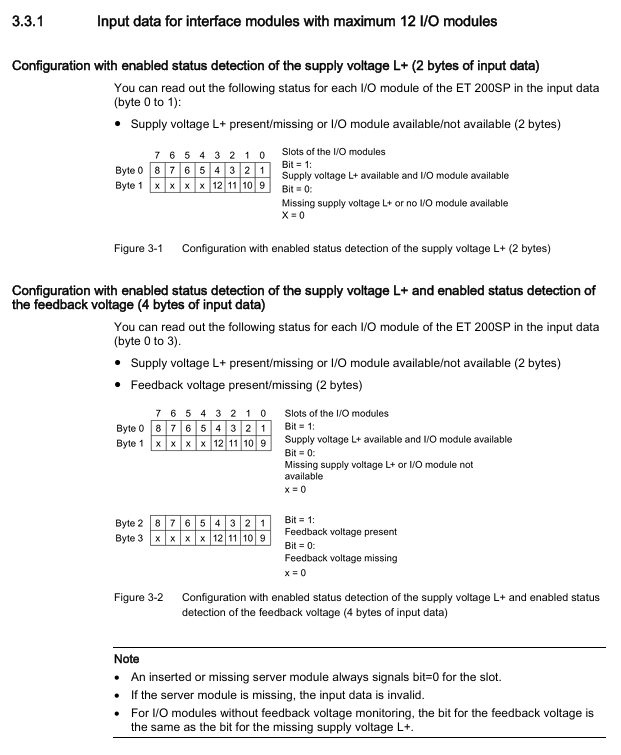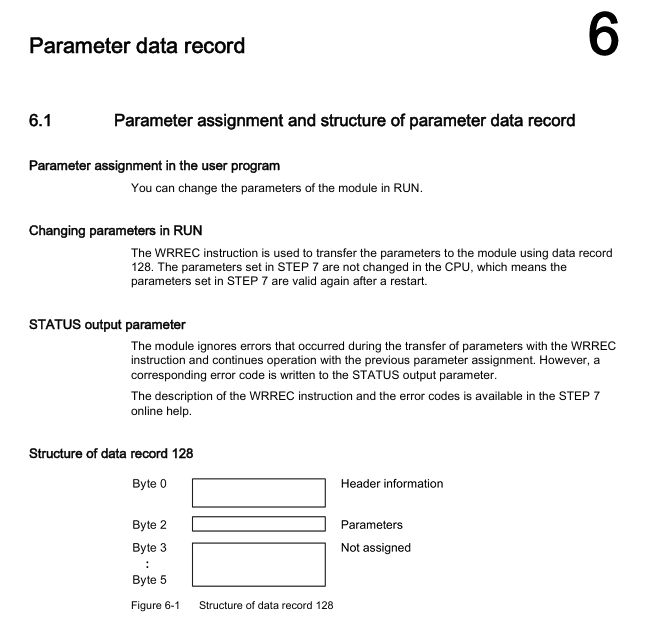

K-WANG


Siemens ET200SP 6ES7193-6PA00-0AA0 server module
Document Structure: Includes 8 core chapters: Preface, Document Guide, Product Overview, Parameter/Address Space, Diagnostic Alarm, Technical Specifications, Parameter Data Recording, Dimensional Drawings, along with supporting safety warning system and compliance instructions.
Siemens ET200SP 6ES7193-6PA00-0AA0 server module
Overview and Basic Product Information
(1) Overview
Type: Siemens SIMATIC ET200SP Server Module Operation Manual, version March 2015 (A5E0357537-AB), is a supplementary document to the ET200SP Distributed I/O System Manual, focusing on module specific functions. System level general functions should refer to the ET200SP System Manual (available through specified links).
Document Structure: Includes 8 core chapters: Preface, Document Guide, Product Overview, Parameter/Address Space, Diagnostic Alarm, Technical Specifications, Parameter Data Recording, Dimensional Drawings, along with supporting safety warning system and compliance instructions.
(2) Product Fundamentals
Model and positioning: Model 6ES7193-6PA00-0AA0 is a server module for the ET200SP distributed I/O system. Its core function is to enclose the backplane bus and provide three backup fuses (5 × 20mm) for storage support. It needs to be used in conjunction with specific CPU/interface modules.
Compatibility: Only supports IM 155-6 PN BA interface module (product version ≥ 1, firmware version ≥ V1.1.1), can be configured through STEP 7 (TIA Portal) or GSD file.

Core functions and features
(1) Basic functions
Hardware Assistance: Integrated backup fuse storage location, convenient for quick access to fuses during on-site maintenance, without the need to carry additional spare parts boxes.
System support: Closed ET200SP backplane bus to ensure stable bus signals and avoid external interference; Support firmware updates, I&M identification data storage, and reconfiguration in RUN mode to enhance system flexibility and maintainability.
Status monitoring: It can monitor the power supply voltage (L+) and feedback voltage status of each slot I/O module in real time, and output the monitoring results through the address space, which is convenient for user programs to read and locate faults.
Device replacement optimization: When there is no topology configuration for IM 155-6 PN BA, the device name can be retained, and there is no need to reconfigure the name parameter after replacing the module, simplifying the replacement process.
(2) Key characteristics
Characteristic Details
Parameter configuration supports the "L+Power Loss Group Diagnosis" parameter (can be enabled/disabled, disabled by default). When enabled, 1 diagnostic message will be generated based on the potential group for L+power loss, regardless of the "L+Power Loss Diagnosis" parameter of the I/O module itself
The address space function outputs input data of different lengths based on the maximum number of I/O modules supported by the CPU/interface module (12/32/64 slots). It can choose to monitor only the power supply voltage or monitor both the power supply voltage and feedback voltage simultaneously
Diagnostic alarm is only a type 1 diagnostic alarm (error code 1BH), corresponding to "server module firmware version invalid (<V1.1.1)", which requires module replacement or firmware upgrade to solve
Parameters and Address Space
(1) Parameter configuration
Configurable parameters: Only one parameter, "L+power loss group diagnosis", with a range of "enable/disable", disabled by default, supports reconfiguration in RUN mode (data recording needs to be transmitted through the "WRREC" command).
Parameter validation logic: After activation, the system generates a diagnosis based on the power supply status of the installed I/O modules in the potential group, requiring no empty slots in the potential group; When the light colored BaseUnit (BU.. D) has no I/O module, the potential group will be merged into the previous potential group. After inserting the I/O module, the potential group will be re identified and the diagnosis will be updated.
(2) Address space rules
1. Data length division
According to the maximum number of I/O modules supported by the CPU/interface module, the input data length is divided into three categories, as follows:
The maximum number of I/O modules supported is to monitor only the power supply voltage (in bytes) while monitoring both the power supply voltage and feedback voltage (in bytes). Only the diagnostic address (with no data) is supported
12 slots 2 4 0
32 slots 4 8 0
64 slots 8 16 0
2. Data interpretation rules
Power supply voltage monitoring: Each I/O module corresponds to one bit, bit=1 indicates "L+power supply is normal and the module exists", bit=0 indicates "L+power supply is missing or the module is not installed"; The server module's own slot outputs bit=0 regardless of whether it is installed or not.
Feedback voltage monitoring: Extra bytes of the same length as the supply voltage are occupied, with 1 bit corresponding to each I/O module. Bit=1 indicates "feedback voltage exists", and bit=0 indicates "feedback voltage is missing"; The I/O module without feedback voltage monitoring function has a bit status that is consistent with the "L+power loss" status (i.e. bit=0).
Data validity: When the server module is missing, all input data is invalid, and the module installation status needs to be checked first.
3. Feedback voltage evaluation
Voltage range definition: When L+supply voltage is greater than 6V, the feedback voltage status is included in the input data; When 6V<feedback voltage ≤ 12V or>12V, corresponding to different system fault scenarios (such as cable crossing), the fault type can be determined by reading the bit status through the user program.
Evaluation scenario: Only when the L+power supply is safely disconnected (as indicated by the safety relay status), the feedback voltage bit=1 (6-12V or>12V) can be used as a fault diagnosis basis to locate system circuit abnormalities.

Technical specifications and installation
(1) Mechanical specifications
Parameter Value
Dimensions (width x height x depth) 7mm x 117mm x 36mm
Weight (approximately) 19g
The fuse supports three 5 × 20mm backup fuses
(2) Installation and Connection
Installation method: Suitable for ET200SP standard installation rails, no additional fasteners required, quick installation through rail buckles, compatible with other ET200SP modules in terms of layout.
Connection requirements: No independent I/O terminals, only connected to the system through the backplane bus, no additional wiring required, automatically connected to the system after installation.
Diagnosis and maintenance
(1) Diagnostic alarm processing
Diagnosis alarm type error code reason solution
Invalid firmware version 1BH server module firmware version<V1.1.1, incompatible with the current system. 1. Replace the server module with firmware version ≥ V1.1.1;
2. Firmware update of existing modules (requires specialized tools and processes)
(2) Parameter data recording
Parameter transmission: To modify parameters in RUN mode, the "WRREC" command is used to write the parameters into data record 128 (bytes 0-5, where byte 2 is the "L+power loss group diagnosis" enable bit, bit=1 enabled).
Error handling: When an error occurs during parameter transmission, the module ignores the error and maintains the original parameter configuration. At the same time, the error code is written into the "STATUS" output parameter. The meaning of the error code can be queried through STEP 7 online help.

- YOKOGAWA
- Energy Access
- Renewable Integration
- Energy Subsidies
- Energy and Water
- Net zero emission
- Energy Security
- Critical Minerals
- A-B
- petroleum
- Mine scale
- Energy and Gender
- Covid-19
- man-machine
- Reliance
- ADVANCED
- SEW
- ProSoft
- WATLOW
- Kongsberg
- FANUC
- VSD
- DCS
- PLC
- Sewage treatment
- cement
- Yaskawa
- Woodward
- BOSCH Rexroth
- MOOG
- General Electric
- American NI
- Rolls-Royce
- CTI
- Honeywell
- EMERSON
- Automobile market
- xYCOM
- Motorola
- architecture
- Industrial information
- New energy
- electricity
- Construction site
- HIMA
- ABB
- Rockwell
- Schneider Modicon
- Siemens
- MAN
- GE
- TRICONEX
- Control Wave
- ALSTOM
- AMAT
- STUDER
- KONGSBERG
- MOTOROLA
- DANAHER MOTION
- Bentley
- Galil
- EATON
- MOLEX
- Triconex
- DEIF
- B&W
- ZYGO
- Aerotech
- DANFOSS
- KOLLMORGEN
- Beijer
- Endress+Hauser
- schneider
- Foxboro
- KB
- REXROTH
- YAMAHA
- Johnson
- Westinghouse
- WAGO
- TOSHIBA
- TEKTRONIX
-
Kollmorgen S33GNNA-RNNM-00 - Brushless Servo Motor
-
Kollmorgen 6sm56-s3000-g-s3-1325 - Servo Motor
-
Kollmorgen AKM52K-CCCN2-00 - Servo Motor
-
Kollmorgen PSR3-230/75-21-202 - Power Supply
-
Kollmorgen akm24d-anc2r-00 - Servo Motor
-
Kollmorgen AKM22E-ANCNR-00 - Servo Motor
-
Kollmorgen S60300-550 - Servo Drive
-
Kollmorgen B-204-B-21 - Servomotor
-
Kollmorgen AKM21E-BNBN1-00 - Servo Motor
-
Kollmorgen TT2953-1010-B - DC Servo Motor
-
Kollmorgen pa8500 - Servo Power Supply
-
Kollmorgen BDS4A-210J-0001-207C2 - Servo Drive
-
Kollmorgen TTRB1-4234-3064-AA - DC Servo Motor
-
Kollmorgen MH-827-A-43 - Servo Motor
-
Kollmorgen AKM24D-ACBNR-OO - Servo Motor
-
Kollmorgen 00-01207-002 - Servo Disk DC Motor
-
Kollmorgen AKM21C-ANBNAB-00 - Servo Motor
-
Kollmorgen PSR3-208/50-01-003 - Power Supply
-
Kollmorgen 6SM56-S3000 - Servo Motor
-
Kollmorgen DBL3H00130-B3M-000-S40 - Servo Motor
-
Kollmorgen 6SN37L-4000 - Servo Motor
-
Kollmorgen AKM65K-ACCNR-00 - Servo motor
-
Kollmorgen 6SM56-L3000-G - Servo Motor
-
Kollmorgen AKMH43H-CCCNRE5K - Servo Motor
-
Kollmorgen PSR4/52858300 - Power Supply
-
Kollmorgen KBM-79H03-E03 - Direct Drive Rotary Motor
-
Kollmorgen AKM33E-ANCNDA00 - Servo Motor
-
Kollmorgen U9M4/9FA4T/M23 - ServoDisc DC Motor
-
Kollmorgen AKM13C-ANCNR-00 - Servo Motor
-
Kollmorgen AKM43L-ACD2CA00 - Servo Motor
-
Kollmorgen AKM54K-CCCN2-00 - Servo Motor
-
Kollmorgen M-605-B-B1-B3 - Servo Motor
-
Kollmorgen AKD-P00606-NBAN-0000 - Rotary Drive
-
Kollmorgen 6SM-37M-6.000 - Servo Motor
-
Kollmorgen A.F.031.5 - Sercos Interface Board
-
Kollmorgen 918974 5054 - Servo PWM
-
Kollmorgen U12M4 - ServoDisc DC Motor
-
Kollmorgen AKD-B00606-NBAN-0000 - Servo Drive
-
Kollmorgen MV65WKS-CE310/22PB - Servo Drive
-
Kollmorgen 65WKS-CE310/22PB - Servo Drive
-
Kollmorgen EM10-27 - Module
-
Kollmorgen S64001 - Servo Drive
-
Kollmorgen CR03200-000000 - Servo Drive
-
Kollmorgen 6SM57M-3000+G - Servo Motor
-
Kollmorgen BDS4 - Servo Drive
-
Kollmorgen AKD-P00306-NBEC-000 - Servo Drive
-
Kollmorgen AKD-B01206-NBAN-0000 - Servo Drive
-
Kollmorgen STP-57D301 - Stepper Motor
-
Kollmorgen 6SM37L-4.000 - Servo Motor
-
Kollmorgen 44-10193-001 - Circuit Board
-
Kollmorgen PRDR9SP24SHA-12 - Board
-
Kollmorgen PRD-AMPE25EA-00 - Servo Drive
-
Kollmorgen DBL3N00130-0R2-000-S40 - Servo Motor
-
Kollmorgen S406BA-SE - Servo Drive
-
Kollmorgen AKD-P00607-NBEI-0000 - Servo Drive
-
Kollmorgen AKD-P01207-NBEC-0000 - Servo Drive
-
Kollmorgen CR03550 - Servo Drive
-
Kollmorgen VSA24-0012/1804J-20-042E - Servo Drive
-
Kollmorgen N2-AKM23D-B2C-10L-5B-4-MF1-FT1E-C0 - Actuator
-
Kollmorgen 04S-M60/12-PB - Servo Drive
-
Kollmorgen H33NLHP-LNW-NS50 - Stepper Motor
-
Kollmorgen A-78771 - Interlock Board
-
Kollmorgen AKM43E-SSSSS-06 - Servo Motor
-
Kollmorgen AKD-P00607-NBEC-0000 - Servo Drive
-
Kollmorgen E21NCHT-LNN-NS-00 - Stepper Motor
-
Kollmorgen cr10704 - Servo Drive
-
Kollmorgen d101a-93-1215-001 - Motor
-
Kollmorgen BDS4A-203J-0001-EB202B21P - Servo Drive
-
Kollmorgen MCSS23-6432-002 - Connector
-
Kollmorgen AKD-P01207-NACC-D065 - Servo Drive
-
Kollmorgen CK-S200-IP-AC-TB - I/O Adapter and Connector
-
Kollmorgen CR10260 - Servo Drive
-
Kollmorgen EC3-AKM42G-C2R-70-04A-200-MP2-FC2-C0 - Actuator
-
Kollmorgen BDS5A-206-01010-205B2-030 - Servo Drive
-
Kollmorgen s2350-vts - Servo Drive
-
Kollmorgen AKM24D-ANC2DB-00 - Servo Motor
-
Kollmorgen E31NCHT-LNN-NS-01 - Stepper Motor
-
Kollmorgen PRD-0051AMPF-Y0 - Servo Board
-
Kollmorgen TB03500 - Module
-
Kollmorgen 60WKS-M240/06-PB - Servo Drive
-
Kollmorgen M21NRXC-LNN-NS-00 - Stepper Motor
-
Kollmorgen H-344H-0212 - Servo Motor
-
Kollmorgen MCSS08-3232-001 - Connector
-
Kollmorgen AKM33H-ANCNC-00 - Servo Motor
-
Kollmorgen PA-2800 - Power Supply
-
Kollmorgen MTC308C1-R1C1 - Servo Motor
-
Kollmorgen PRDR0091300Z-00 - Capacitor Board
-
Kollmorgen BDS4A-206J-0024/01502D79 - Servo Drive
-
Kollmorgen S20330-VTS - Servo Drive
-
Kollmorgen S20250-CNS - Servo Drive
-
Kollmorgen SBD2-20-1105-WO - Servo Drive Board
-
Kollmorgen M405-C-A1--E1 - Servo Motor
-
Kollmorgen PRD-PB805EDD-00 - Servo Drive
-
Kollmorgen 6SM57S-3.000-J-09-HA-IN - Servo Motor
-
Kollmorgen AKM33H-ANCNDA-00 - Servo Motor
-
Kollmorgen PCB-00030200-04 - PCB
-
Kollmorgen H22SSLB-LNN-NS-02 - Stepper Motor
-
Kollmorgen BJRL-20012-110001 - Module
-
Kollmorgen BDS4A-206J-0001404A - Servo Drive
-
Kollmorgen H-342-H-0802 - Servo Motor
-
Kollmorgen CR10561 - Servo Drive
-
Kollmorgen BDS5A-206-00010-205B2-030 - Servo Drive
-
Kollmorgen BDS5A-206-00010-207B-2-030 - Servo Drive
-
Kollmorgen mcss08-3224-001 - Connector
-
Kollmorgen M-207-B-23-B3 - Servo Motor
-
Kollmorgen PRD-0041200Z-S0 - Encoder/Resolver Card
-
Kollmorgen MH-225-G-61 - Motor
-
Kollmorgen MT308B1-T1C1 - Servo Motor
-
Kollmorgen BDS4A-240J-0001604C83 - Servo Drive
-
Kollmorgen 6SM57-S-3000 - Servo Motor
-
Kollmorgen N-T31V-15-5B-6-MF3-FT1E-C251 - Actuator
-
Kollmorgen PRD-0051AMPA-X0 - Servo Board
-
Kollmorgen CF-SS-RHGE-09 - Cable
-
Kollmorgen DIGIFAS7204 - Servo Drive
-
Kollmorgen S30101-NA - Servo Drive
-
Kollmorgen DIGIFAS7201 - Servo Drive
-
Kollmorgen PRD-0051AMPA-Y0 - Servo Board
-
Kollmorgen AKM23D-EFCNC-00 - Servo Motor
-
Kollmorgen SE10000 - Servo Drive
-
Kollmorgen PSR4/5A-112-0400 - Power Supply
-
Kollmorgen AKM31H-ANCNC-01 - Servo Motor
-
Kollmorgen M-203-B-93-027 - Servo Motor
-
Kollmorgen CP-SS-G1HE-05 - Connector
-
Kollmorgen AKM42G-ASCNR-02 - Servo Motor
-
Kollmorgen DBL4N00750-B3M-000-S40 - Servo Motor
-
Kollmorgen R3-BK23-152B-12-PL-ASE-BS115 - Actuator
-
Kollmorgen MH-427-B-61 - Motor
-
Kollmorgen cr06902 - Servo Drive




